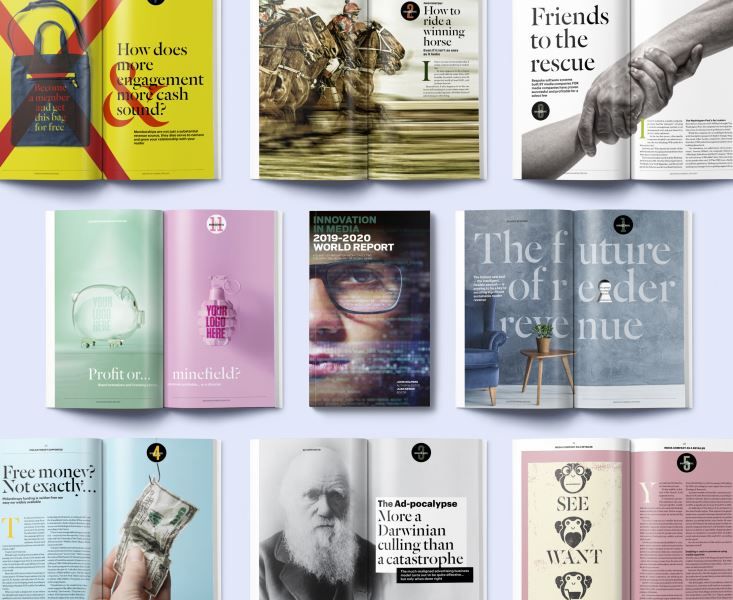
20 Feb PATH TO A SUSTAINABLE FUTURE
HOW THE PUBLISHING INDUSTRY IS AIMING FOR MAXIMUM POSITIVE IMPACT
As the issue of sustainability becomes increasingly topical – and increasingly pressing – publishers are recognising the need to widen their sustainability agenda and develop businesses that are equipped to meet future challenges.
Sustainability and environmental impact have never been hotter topics.
On a global scale, 2018 was one of the hottest years on record. In fact, 17 of the past 18 years have been the warmest in memory.
Not only is the planet getting hotter, extreme weather-related events including droughts, floods, hurricanes, wild fires and record high temperatures are becoming increasingly commonplace. Add to this species extinction, major concerns around access to water and growing disquiet over poverty and inequality, and it is glaringly evident that the environment and sustainability need to be high on the agenda of both consumers and corporates.
The publishing industry is not immune to this. In fact, as a user of natural resources, though potentially sustainable, responsible publishers today are increasingly asking what their role should be to meet sustainability challenges and with it achieve maximum positive impact.
Some publishers have already put themselves at the forefront of the sustainability debate, driving change beyond merely compliance “box ticking” to meet environmental standards – with some already demonstrable and impressive results.
The Economist Group, for example, has been working with fellow members through the work of the Professional Publishers Association’s (PPA) Sustainability Action Group to reduce energy-related threats and build on opportunities to improve public awareness of the sustainability credentials of paper.
The Economist is also working with supply chain partners to respond to the potential risks and impact of future environmental policy regulations and taxation.

Hearst UK, which engages 16 million people every month through printed and digital brands has launched its own commitment to sustainability. Entitled ‘Planet Hearst’, the plan is built on six objectives that are reviewed annually and also calls on employees to take individual responsibility to ensure the company’s Environmental Management System is complied with and contributed to.
Many of those tackling the challenge have used the United Nations’ 17 Sustainable Development Goals, which all UN Member States have signed up to collectively strive to reach by 2030, as a reference point. These are pivotal building blocks to achieving a better and more sustainable future for all. This “blueprint” is in equal measure an ambitious and challenging response to the mega-trends that threaten sustainable development across the globe.
What is clear is that the challenges for publishers extend far beyond traditional sustainability practices focused on ecosystems, forest management and global warming, into the realm of human rights, gender equality, poverty eradication and infrastructure development.
Partnership is key
While due credit should be given to those players who have taken the initiative to develop and enhance their own sustainability agenda, now is
as pertinent a time as ever to refresh and refocus the industry’s overall approach to sustainability.
“Reaching sustainability success as an industry will depend on how we integrate our efforts across sourcing, production, people and value creation,” says John Sanderson, Head of Environment for UK and Ireland at global Biofore company UPM. “A sustainability agenda alone is clearly not enough. Even if organisations are individually adopting common goals to sustainable development, coordinating these efforts remains a complex and challenging task. If we work in silos we will not achieve the greatest change. We need partnerships and we need to integrate our actions.”

UPM is certainly embracing this philosophy. UPM Communication Papers, one of six business areas within UPM, has committed to being “a world leader” in sustainable and high-performance papers – and actively works with partners to deliver sustainability success.
The business produces around 8.2 million metric tons of paper per year and employs approximately 8,000 people worldwide. The UPM Communication Papers division, headquartered in Germany, has production plants in Finland, Germany, the UK, France, Austria and the US – and the entire business is based on sustainable forestry. UPM’s brand promise ‘UPM Biofore – Beyond fossils’ reflects UPM’s purpose to seize the limitless potential of bioeconomy and gives a long-term direction for the development of the industry and UPM as a company. Biofore is an acronym created in 2009 to describe the transformation of forest industry.
UPM was the first in forest industry to define itself as a company which combines bioeconomy and forest industry into one. UPM’s strategy is crystallised in Biofore.
UPM Biofore – Beyond fossils stands for:
• Inspired by the limitless opportunities of bioeconomy
• Delivering renewable and responsible solutions
• Innovating for a future beyond fossils.
This all begins with responsibly grown wood biomass that is processed into renewable, innovative, high-quality products. For example, UPM plants 100 tree seedlings every single minute, equating to more than 50m a year, sustaining forests which clean water, purify the air and act as carbon sinks.
The future is paper
The company has also committed itself to wood, not only as a sustainable raw material for paper but also as a source of other innovative materials and sustainable energy.
Working with Non-Governmental Organisations (NGOs), such as Greenpeace and WWF, government authorities, land owners and customers, UPM has focused its agenda on delivering on paper’s potential as a sustainable solution, which provides for the needs of future consumers.
UPM believes that if paper were invented today, it would be viewed “as the most innovative and environmentally responsible product of the past 50 years”, because of the efforts paper suppliers have gone to and the investments they have made to ensure its sustainability.
UPM is certainly well recognised for its role in this. In 2018, the company was listed for the sixth time as the forest and paper industry leader in the Dow Jones European and World Sustainability Indices, and also recognised as a Global Compact LEAD company for its strong engagement to the United Nations Global Compact. It is also one of the top 100 sustainable companies globally, selected by Corporate Knights.
Through its Sustainability Agenda, UPM Communication Papers has committed to working together with the publishing industry and its suppliers in expanding the sustainability debate and developing future-proof solutions. These types of steps might yet mean the publishing industry plays a crucial role in tackling the global issues of tomorrow.



